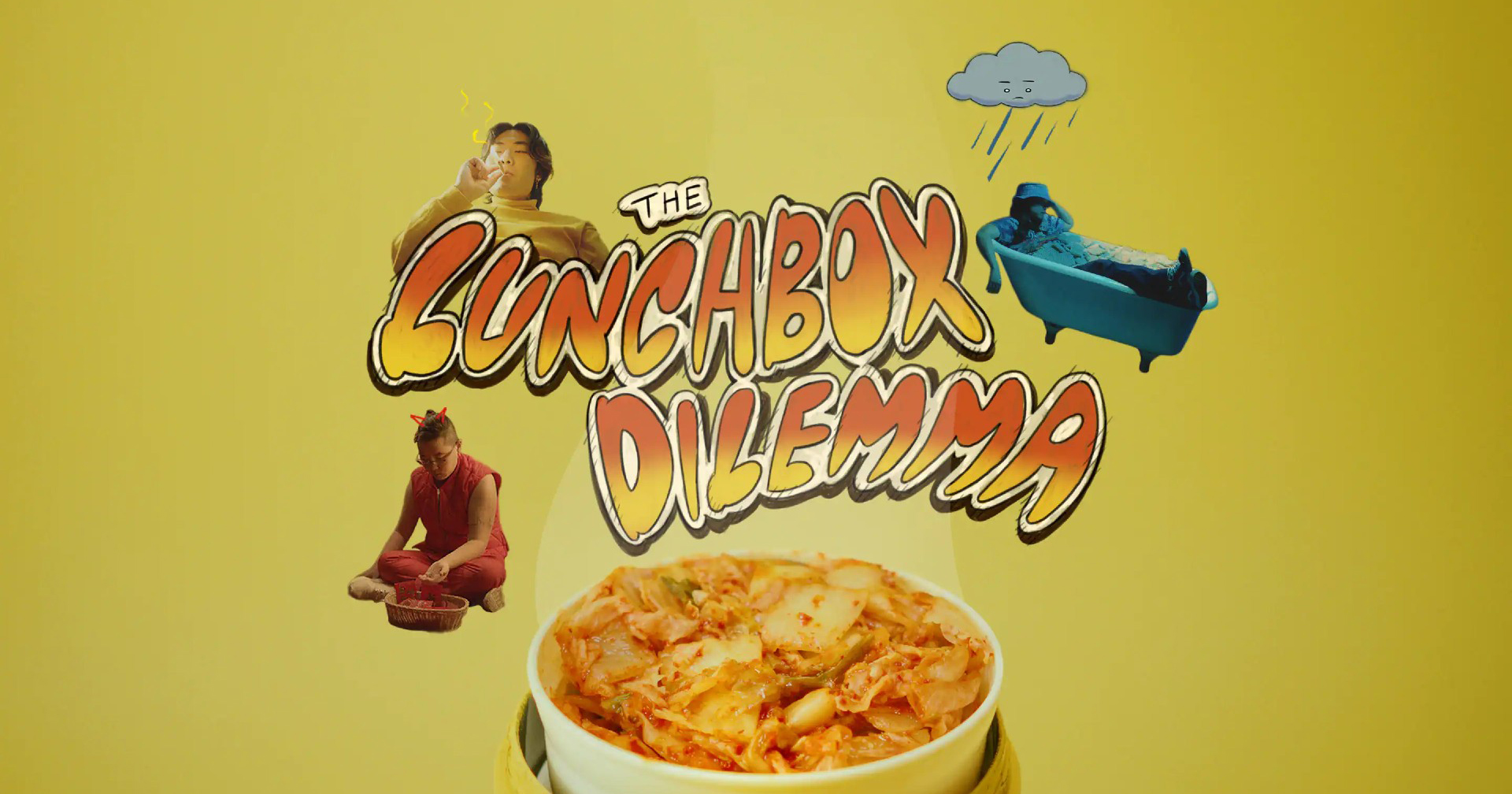Am I normal? It’s a concept embedded into the three-part Canadian docuseries, The Lunchbox Dilemma. Each five-minute episode explores the inner workings of a child’s mind and the feelings of Otherness that stem from eating cultural lunches in front of classmates who would often dub them “smelly”.
The Lunchbox Dilemma‘s director Yú captures the dichotomy between the minority child’s all-consuming desire to fit in and being true to who you are. Joe Rascal, Vanessa Okafo and Yang Chen recount growing up as Asian-Canadians in Ontario and question Otherness through the dilemma of whether to hide your Asian lunch from classmates, or eat it and be subject to ridicule.
The Lunchbox Dilemma shows how natural it is for minority children to self-monitor their actions to blend in before they even understand the concept of Otherness or racism.
“The unfiltered stories needed to come from childhood to show that we felt and acted differently before we even understood what a minority is,” says Yú. “The Lunchbox Dilemma is rooted in an experience before a child understands racism, but they can still see that they’re different. As a kid, you don’t immediately come to the conclusion that you’re different, you just notice how others react to you. There’s one part of yourself that wants to fit in, so you’re embarrassed about your lunch being weird or smelly, and there’s another part that wants to enjoy these foods and be proud of who you are.”
Yú didn’t realize until filming the series that The Lunchbox Dilemma is relatable to many. “When the team would go on break, everyone would talk about their own lunchbox dilemmas,” she recalls being on set. “To have had those discussions was really cathartic. To see that it wasn’t just the artists on-screen that had stories but the crew as well.”
“The Lunchbox Dilemma is rooted in an experience before a child understands racism, but they can still see that they’re different. As a kid, you don’t immediately come to the conclusion that you’re different, you just notice how others react to you. There’s one part of yourself that wants to fit in, so you’re embarrassed about your lunch being weird or smelly, and there’s another part that wants to enjoy these foods and be proud of who you are.”
– Yú
From pre- to post-production, The Lunchbox Dilemma crew was predominantly Asian-Canadian. Whether through the thoughtfully implemented production design, equipped with popular Korean snacks or lazy Susans atop a Chinese-style roundtable, the details are meticulous.
“Having collaborators that understand the cultural components involved to accurately portray each story was important to me,” Yú confirms. “Even with our animator Aiken Chau, I talked about creating a brothy Chinese soup, and without any more direction, he produced exactly what I was thinking.”
The integration of the collective Asian-Canadian lunch experience persists on thelunchboxdilemma.com. The nostalgic, Y2K-inspired website brings millennials back to their childhood, flush with Windows XP and MSN Messenger group chats viewers can scroll through. The group chat contains first-person accounts of lunchbox dilemmas.
“Those are all thoughts and feelings from the cast and crew,” Yú expands on the vision for the website. “We collected testimonials from the crew on their own experience and then formatted it conversationally. The website designer Leanne Macaspac came up with the idea to fit this in the form of an MSN Messenger chat. I wanted their stories to be included to show others that it really is a community of people who have experienced this.”

Including Yú.
Yú remembers bringing pork and cabbage dumplings for lunch and the quips of disgust that followed when she lifted the lid of her Tupperware.
“Classmates would be like, ‘ew, what’s that smell’ and ‘that smells so gross,'” she says.
Following these repeated incidents, Yú wouldn’t take her lunch out, snacking on carrot sticks for fear of offending someone – a habit that continued until high school.
“I was so embarrassed about food from my culture that I hid it with so much persistence just so people wouldn’t think I was so Asian,” she said. “I think back on those experiences, of me having to hide myself and then of the kids that made fun of me, and I wonder what would have happened if they had grown up and seen kids eating dumplings in commercials and on television. Then maybe me eating dumplings would no longer be different.”
At the time, Yú may not have been familiar with the concept of Otherness, but she had a deep understanding. Her work on The Lunchbox Dilemma aims to change the portrayal of Asian-Canadians.
“Kids need to grow up seeing us portrayed in mainstream media to make it normalized,” she notes. “If growing up, we had more multifaceted, Asian-Canadian representation, what’s different could be considered normal by now.”
“Kids need to grow up seeing us portrayed in mainstream media to make it normalized. If growing up, we had more multifaceted, Asian-Canadian representation, what’s different could be considered normal by now.”
-Yú
Through telling Joe, Vanessa and Yang’s stories, Yú came to a turning point in her own story. The Lunchbox Dilemma helped Yú identify ways she could be more true to herself. Professionally, prior to The Lunchbox Dilemma, Yú only used her English name but now, she explains, “I just want to do the things that are more comfortable and feel right to me.”
Although The Lunchbox Dilemma started as a passion project, others have recognized the importance of sharing these experiences. With docuseries now streaming on CBC Gem, more people can watch and understand the hardships involved in growing up as an Asian-Canadian. With work like Yú’s, we can shift the view of what is normal and help minority children feel comfortable with showing who they are – smelly cabbage and all.
Yú is a director signed to Toronto-based production company Breathe Entertainment, a collective of designers, cinematographers and directors sharing a pursuit of truthful storytelling. View her work at how-yu.site/.
Like this post? Follow The RepresentASIAN Project on Instagram, TikTok and YouTube to keep updated on the latest content.











